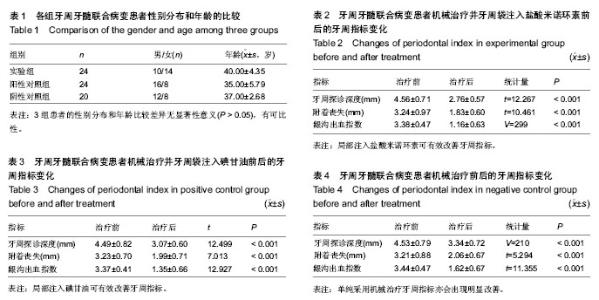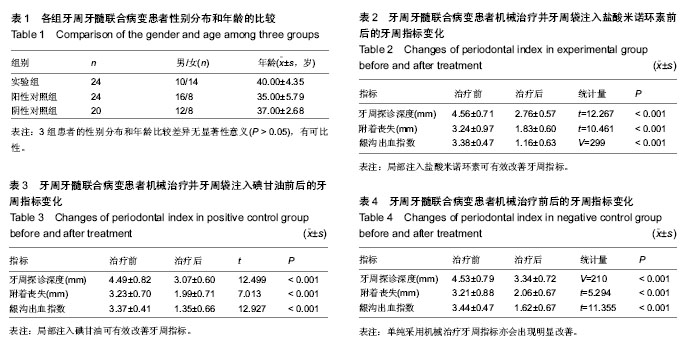| [1] Simring M,Goldberg M.The pulpal pocket approach: Retrograde periodontitis. J Periodontol.1964;35:22-48.
[2] 孟焕新.牙周病学[M].4版.北京:人民卫生出版社,2013:189-194.
[3] Sunitha V R, Emmadi P,Namasivayam A,et al.The periodontal- endodontic continuum: A review.J Conserv Dent.2008;11(2):54-62.
[4] Cobb CM.Non-surgical pocket therapy:mechanical.Ann Periodontol.1996;1:443-490.
[5] Gopal S,Pavankumar K,Shetty KP,et al.Interrelationship of endodontic-periodontal lesions - an overview.Indian J Dent Sci.2011;2(3):55-59.
[6] Kalsi R,Vandana KL,Prakash S.Effect of local drug delivery in chronic periodontitis patients: A meta-analysis. J Indian Soc Periodontol.2011;15:304-309.
[7] Zehnder M,Gold SI,Hasselgren G.Pathologic interaction in pulpal and periodontal tissues.J Clin Periodontol. 2002;29: 663-671.
[8] Haffajee AD,Socransky SS.Microbial etiological agents of destructive periodontal diseases.Periodontol 2000;1994; 5: 78-111.
[9] Kobayashi T,Hayashi A,Yoshikawa R,et al.The microbial flora from root canals and periodontal pockets of non-vital teeth associated with advanced periodontitis.Int Endod J. 1990; 23(2):100-106.
[10] 周康,季佩红,俞立英,等.牙周牙髓联合病变牙周袋内厌氧菌的培养检测和药敏试验[J].上海口腔医学,2013,22(1):72-76.
[11] Goodson JM,Haffajee A,Socransky SS.Periodontal therapy by local drug delivery of tetracycline.J Clin Periodontol. 1979; 6:83-92.
[12] Wakabayashi H,Yamauchi K,Kobayashi T,et al.Inhibitory effects of lactoferrin on growth and biofilm formation of Porphyromonas gingivalis and Prevotella intermedia. Antimicrob Agents Chemother.2009;53(8):3308-3316.
[13] Bland PS,Goodson JM,Gunsolley JC,et al.Association of antimicrobial and clinical efficacy: periodontitis therapy with minocycline microspheres.J Int Acad Periodontol. 2010;12: 11-19.
[14] Bastos LF,Merlo LA,Rocha LT,et al.Characterization of the antinociceptive and anti-inflammatory activities of doxycycline and minocycline in different experimental models.Eur J Pharmacol. 2007;5:176-177.
[15] 任蕾,杨圣辉,刘颖.牙周炎常见菌对抗菌药物的筛选及活性测定[J].现代口腔医学杂志, 2000,14(4):256-257.
[16] Jones AA,Kornman KS,Newbold DA,et al.Clinical and microbiological effects of controlled-release locally eliveredminocycline in periodontitis.J Periodontol. 1994; 65(11): 1058-1060.
[17] Brayden DJ.Controlled release technologies for drug delivery. Drug Discov Today.2003;8(21):976-978.
[18] Sedlacek MJ,Walker C.Antibiotic resistance in an in vitro subgingival bio?lm model.Oral Microbiol Immunol. 2007;22: 333-339.
[19] Persson GR,Salvi GE,Heitz-Mayfield LJ,et al.Antimicrobial therapy using a local drug delivery system (Arestin) in the treatment of peri-implantitis. I: Microbiological outcomes.Clin Oral Implants Res. 2006;17(4):386-393.
[20] Eguchi T,Koshy G,Umeda M,et al.Microbial changes in patients with acute periodontal abscess after treatment detected by Pado Test.Oral Dis.2008;14(2):180-184.
[21] Lu HK,Chei CJ.Efficacy of subgingivally applied minocycline in the treatment of chronic periodontitis.J Periodont Res. 2005;40:20-27.
[22] Paquette D,Oringer R,Lessem J,et al.Locally delivered minocycline microspheres for the treatment of periodontitis in smokers.J Clin Periodontol.2003;30(9):787-794.
[23] McColl E,Patel K,Dahlen G,et al.Supportive periodontal the raspy using mechanical instrumentation or 2% minocycline gel: a 12 month randomized, controlled, single masked pilot study.J Clin Periodontol.2006;33:141-150. |

